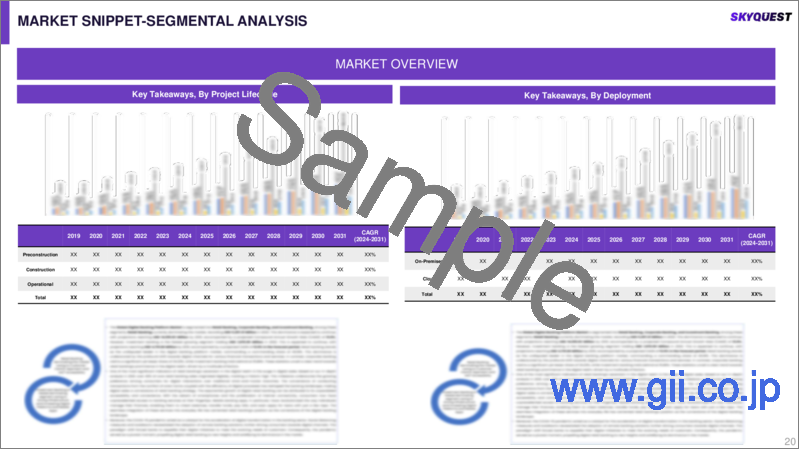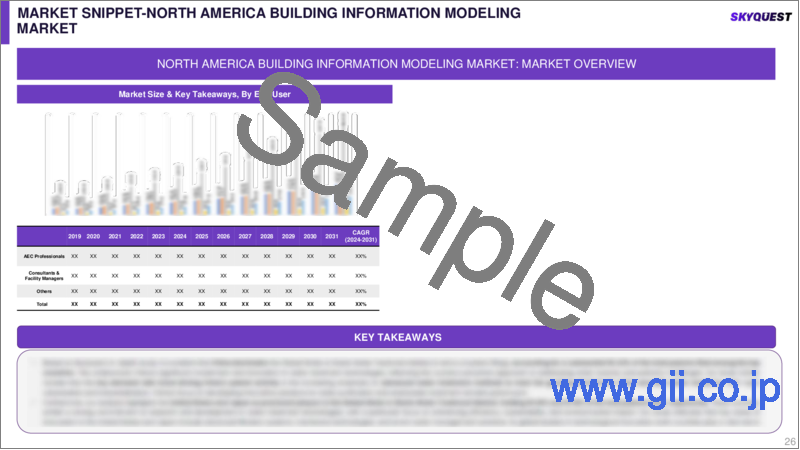|
|
市場調査レポート
商品コード
1360390
BIM (ビルディングインフォメーションモデリング) の世界市場 (2023-2030年):コンポーネント (ソフトウェア・サービス)・用途 (商業・住宅) 別の規模・シェア・成長分析・予測Global Building Information Modeling Market Size, Share, Growth Analysis, By Component(Software and services), By Application(Commercial, residential) - Industry Forecast 2023-2030 |
||||||
|
|||||||
| BIM (ビルディングインフォメーションモデリング) の世界市場 (2023-2030年):コンポーネント (ソフトウェア・サービス)・用途 (商業・住宅) 別の規模・シェア・成長分析・予測 |
|
出版日: 2023年09月28日
発行: SkyQuest
ページ情報: 英文 157 Pages
納期: 3~5営業日
|
- 全表示
- 概要
- 目次
世界のBIM (ビルディングインフォメーションモデリング) の市場規模は、2021年の59億5,000万米ドル、2022年の67億1,000万米ドルから、予測期間中は12.8%のCAGRで推移し、2030年には175億9,000万米ドルの規模に成長すると予測されています。
促進要因
建設部門における持続可能なアプローチへの注力の拡大により、BIMソフトウェアへの要求が大きく拡大しています。このソフトウェアは、設計者やエンジニアが建物の効率を高め、エネルギー使用量を抑制し、二酸化炭素排出量を削減し、グリーンビルディングの資格を取得するのを容易にします。
抑制要因
BIMソフトウェアの導入には、ハードウェア、ソフトウェア、トレーニングに多大なコストを必要とします。これは、特に資金力に制約のある中小企業や建設会社にとって障壁となる可能性があります。
市場動向
クラウドベースのBIMソリューションの統合が、リモートアクセシビリティ、コラボレーション機能、拡張性などの有利な特徴により、勢いを増しています。
当レポートでは、世界のBIM (ビルディングインフォメーションモデリング) の市場を調査し、市場概要、市場への各種影響因子の分析、技術・イノベーションの動向、法規制環境、市場規模の推移・予測、各種区分・地域別の内訳、競合情勢、主要企業のプロファイルなどをまとめています。
目次
エグゼクティブサマリー
親市場分析
- 市場概要
- 市場規模
- 市場力学
- 促進要因
- 機会
- 抑制要因
- 課題
- 主要市場洞察
- 技術分析
- 価格分析
- サプライチェーン分析
- バリューチェーン分析
- 市場のエコシステム
- IP分析
- 貿易分析
- スタートアップ分析
- 原材料分析
- イノベーションマトリックス
- パイプライン製品の分析
- マクロ経済指標
- 主要投資分析
- 主要成功要因
- 競合の程度
- 市場力学と展望
- 市場力学
- 促進要因
- 機会
- 抑制要因
- 課題
- 市場力学
- 規制状況
- ポーターの分析
- 将来のディスラプションに関するSkyquestの特別な洞察
世界のBIM (ビルディングインフォメーションモデリング) 市場:コンポーネント別
- 市場概要
- ソフトウェア
- サービス
世界のBIM (ビルディングインフォメーションモデリング) 市場:用途別
- 市場概要
- 商用
- 住宅
- 機関
- 産業用
世界のBIM (ビルディングインフォメーションモデリング) 市場:地域別
- 市場概要
- 北米
- 欧州
- アジア太平洋
- ラテンアメリカ
- 中東・アフリカ
競合情勢
- トップ5社の比較
- 主要企業の市場での位置付け
- 主要企業の採用戦略
- 主要成功戦略
- 市場における最近の活動
- 主要企業の市場シェア
- 主要企業プロファイル
- Autodesk, Inc.
- Bentley Systems, Incorporated
- Trimble Inc.
- Nemetschek SE
- Dassault Systemes SE
- Hexagon AB
- Asite Limited
- Aveva Group plc
- Archidata Inc.
- RIB Software SE
- Beck Technology Ltd.
- Graphisoft SE
- Vectorworks, Inc.
- Procore Technologies, Inc.
- Newforma, LLC
- PlanGrid, Inc.
- Accruent, LLC
- PlanRadar GmbH
- Bluebeam, Inc.
- ConstructConnect
Global Building Information Modeling Market size was valued at USD 5.95 billion in 2021 and is poised to grow from USD 6.71 billion in 2022 to USD 17.59 billion by 2030, at a CAGR of 12.8% during the forecast period (2023-2030).
The Global Building Information Modeling (BIM) Market is a rapidly growing sector that utilizes digital tools to create, manage, and share construction project data. BIM enhances collaboration among stakeholders, improves project efficiency, and reduces errors. The market is driven by increased construction activities, demand for cost-effective solutions, and government initiatives promoting BIM adoption. Key players offer software solutions for 3D modeling, clash detection, and data management. As the construction industry continues to evolve, the BIM market is expected to expand, transforming how buildings are designed, constructed, and operated. \
Top-down and bottom-up approaches were used to estimate and validate the size of building information modeling and to estimate the size of various other dependent submarkets. The research methodology used to estimate the market size includes the following details: The key players in the market were identified through secondary research, and their market shares in the respective regions were determined through primary and secondary research. This entire procedure includes the study of the annual and financial reports of the top market players and extensive interviews for key insights from industry leaders such as CEOs, VPs, directors, and marketing executives. All percentage shares split, and breakdowns were determined by using secondary sources and verified through Primary sources. All possible parameters that affect the markets covered in this research study have been accounted for, viewed in extensive detail, verified through primary research, and analyzed to get the final quantitative and qualitative data.
Drivers
By the rising emphasis on sustainable approaches within the construction sector, there is a notable surge in the requirement for BIM software. This software facilitates designers and engineers in enhancing building efficiency, curbing energy usage, lowering carbon footprints, and attaining green building credentials. A case in point is the Sydney Opera House architects who employed BIM software to devise a more energy-frugal HVAC system, resulting in a 10% reduction in energy consumption. This trend reflects a growing drive towards ecologically responsible construction practices.
Restraints
Incorporating BIM software necessitates notable expenditures on hardware, software, and training. This can pose a hurdle, particularly for small and medium-sized enterprises (SMEs) and construction companies operating with constrained financial resources.
Market Trends
Integration of cloud-based BIM solutions is gaining momentum due to their advantageous features including remote accessibility, collaborative capabilities, and scalability. An instance of this trend is seen in Autodesk's BIM 360 platform, which operates in the cloud and empowers project groups to engage in live collaboration, subsequently mitigating the potential for mistakes and project disruptions.
Table of Contents
Executive Summary
- Market Overview
- Wheel of Fortune
- Research Methodology
- Information Procurement
- Secondary & Primary Data Sources
- Market Size Estimation
- Market Assumptions & Limitations
Parent Market Analysis
- Market Overview
- Market Size
- Market Dynamics
- Drivers
- Opportunities
- Restraints
- Challenges
- Key Market Insights
- Technology Analysis
- Pricing Analysis
- Supply Chain Analysis
- Value Chain Analysis
- Ecosystem of the Market
- IP Analysis
- Trade Analysis
- Startup Analysis
- Raw Material Analysis
- Innovation Matrix
- Pipeline Product Analysis
- Macroeconomic Indicators
- Top Investment Analysis
- Key Success Factor
- Degree of Competition
- Market Dynamics & Outlook
- Market Dynamics
- Drivers
- Opportunities
- Restraints
- Challenges
- Regulatory Landscape
- Porters Analysis
- Competitive rivalry
- Threat of Substitute Products
- Bargaining Power of Buyers
- Threat of New Entrants
- Bargaining Power of Suppliers
- Skyquest Special Insights on Future Disruptions
- Political Impact
- Economic Impact
- Social Impact
- Technical Impact
- Environmental Impact
- Legal Impact
- Global Building Information Modeling Market by Component
- Market Overview
- Software and services
Global Building Information Modeling Market by Application
- Market Overview
- Commercial
- residential
- institutional
- and industrial
- Global Building Information Modeling Market Size by Region
- Market Overview
- North America
- USA
- Canada
- Europe
- Germany
- Spain
- France
- UK
- Rest of Europe
- Asia Pacific
- China
- India
- Japan
- South Korea
- Rest of Asia-Pacific
- Latin America
- Brazil
- Rest of Latin America
- Middle East & Africa (MEA)
- GCC Countries
- South Africa
- Rest of MEA
- Competitive Landscape
- Top 5 Player Comparison
- Market Positioning of Key Players, 2021
- Strategies Adopted by Key Market Players
- Top Winning Strategies
- By Development
- By Company
- By Year
- Recent Activities in the Market
- Key Companies Market Share (%), 2021
- Key Company Profiles
- Autodesk, Inc. (US)
- Company Overview
- Business Segment Overview
- Financial Updates
- Key Developments
- Bentley Systems, Incorporated (US)
- Company Overview
- Business Segment Overview
- Financial Updates
- Key Developments
- Trimble Inc. (US)
- Company Overview
- Business Segment Overview
- Financial Updates
- Key Developments
- Nemetschek SE (Germany)
- Company Overview
- Business Segment Overview
- Financial Updates
- Key Developments
- Dassault Systemes SE (France)
- Company Overview
- Business Segment Overview
- Financial Updates
- Key Developments
- Hexagon AB (Sweden)
- Company Overview
- Business Segment Overview
- Financial Updates
- Key Developments
- Asite Limited (UK)
- Company Overview
- Business Segment Overview
- Financial Updates
- Key Developments
- Aveva Group plc (UK)
- Company Overview
- Business Segment Overview
- Financial Updates
- Key Developments
- Archidata Inc. (Canada)
- Company Overview
- Business Segment Overview
- Financial Updates
- Key Developments
- RIB Software SE (Germany)
- Company Overview
- Business Segment Overview
- Financial Updates
- Key Developments
- Beck Technology Ltd. (US)
- Company Overview
- Business Segment Overview
- Financial Updates
- Key Developments
- Graphisoft SE (Hungary)
- Company Overview
- Business Segment Overview
- Financial Updates
- Key Developments
- Vectorworks, Inc. (US)
- Company Overview
- Business Segment Overview
- Financial Updates
- Key Developments
- Procore Technologies, Inc. (US)
- Company Overview
- Business Segment Overview
- Financial Updates
- Key Developments
- Newforma, LLC (US)
- Company Overview
- Business Segment Overview
- Financial Updates
- Key Developments
- PlanGrid, Inc. (US)
- Company Overview
- Business Segment Overview
- Financial Updates
- Key Developments
- Accruent, LLC (US)
- Company Overview
- Business Segment Overview
- Financial Updates
- Key Developments
- PlanRadar GmbH (Austria)
- Company Overview
- Business Segment Overview
- Financial Updates
- Key Developments
- Bluebeam, Inc. (US)
- Company Overview
- Business Segment Overview
- Financial Updates
- Key Developments
- ConstructConnect (US)
- Company Overview
- Business Segment Overview
- Financial Updates
- Key Developments






